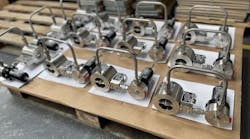Oil and gas producers are moving at breakneck speed to drill and develop new wells, but they face constraints that slow them down and do not allow full optimization of their producing assets. Because they are constrained in terms of time, manpower, and sometimes budget, producers increasingly are turning to simulation models of fields to help make informed decisions on where to drill in order to maximize production. Toward the end of a field’s life, producers may call on simulation models again to determine ways to squeeze more out of the aging asset.
“The real problem has been, until recently, to cover the levels of uncertainty that are present in terms of subsurface description,” says Adam Little, director of engineering services for Energy Scitech Ltd. “If you have the money, you can purchase the necessary C.P.U. capacity to run the simulations you need. However, you don’t always have the necessary people who know how to design and run the simulations. That’s where we come in.”
Energy Scitech Ltd. is an England-based consultancy and software development company specializing in the oil and gas industry. The company recently was acquired by Roxar AS in a move designed to bolster Roxar’s reservoir and production modeling capabilities.
Energy Scitech’s flagship product is EnABLE, a history matching and uncertainty estimation software product. EnABLE allows for better understanding and measuring uncertainty in reservoir production performance predictions, and in optimizing exploitation plans for oil and gas fields.
Little explains how EnABLE fits into the planning process with an example. “Let’s think of a reservoir as a city. Geoscientists, who shoot seismic and build a graphic representation of the data, can be thought as drawing a roadmap of the city. Reservoir engineers are the ones who predict traffic flow. We at Energy Scitech are in the traffic flow part of the business.”
Energy Scitech’s contribution to the traffic flow is to take the interpreted seismic data, as well as any initial geological description of the reservoir, and then use history matching and uncertainty estimation to predict how a field will perform.
The power of EnABLE is its ability to perform history matching - making reasonable adjustments to key properties in a base geological model until observed data are adequately reproduced. EnABLE is not a reservoir simulation, rather it is a tool that calibrates simulation models against prior observations by adjusting input data in order to reproduce or match past performance.
“In most simulations, there is a vast amount of uncertainty in terms of reservoir properties - permeability, volumes, presence or absence of faults, phase flow behavior - making the simulation a highly dimensional and non-unique problem,” Little says. “Most simulations will build a base model with a number of assumptions in it, and sensitivities are performed around the base model by varying one or two of the uncertain parameters.
“Because some simulation models might take 5-6 hours to run, and you’ve got such a vast array of parameters that can be manipulated, you don’t have the luxury of running 10,000 simulation runs to arrive at an output that adequately covers the range of outcomes possible.”
Historically, reservoir simulation models have been constructed from deterministic data, which are sparse and frequently highly uncertain. With the advent of more powerful and less expensive computing equipment, more sophisticated software tools have been developed to allow history matching of more detailed reservoir models.
An EnABLE study begins with an automated experimental design step, after which the parameters of a history match are defined, if there is an observed history. Outputs of interest in the prediction space are then identified; as the simulation runs, EnABLE continuously evaluates these outputs and compares values from previous simulation runs. The software updates the important items, or match modifiers, through each iteration until the overall uncertainty is minimized and the predicted result comes as close to the observed result as possible.
This structured way of processing data allows one to vary up to 100 different parameters simultaneously, and produces a predicted result in a significantly smaller number of simulation runs. “Because the simulation is done in a structured way, one can do tens or hundreds of simulation runs rather than hundreds of thousands and arrive at the same result,” says Little.
The output from EnABLE depends largely on what the target is, but typically is an economic indicator such as net present value or internal rate of return. While some simulation models allow for an approximate determination of worst case, most likely case, best case (often optimistically labeled P10, P50 & P90), “we output the whole probabilistic envelope for a given development scenario - from P-1 to P-99,” Little says.
Optimization from beginning to the end
Although originally developed to assist in history matching, EnABLE can be used at any stage of an asset’s life. Little stresses that the inputs and goals change, however, because different information on the reservoir is available during different stages of field life. “At the beginning of the field life, one is attempting to estimate production potential based on seismic interpretations and experience in similar, but developed, fields. Toward the end of the field life, one is calibrating the geology by trying to reproduce actual observed data from the field.”
When using history matching for an aging field, the theory is that if you can reproduce the past (via simulation), then you can predict the future. Little explains that reality is not quite this easy. “Even though you are dealing with actual historical production and reservoir data, the dimensionality of the problem is still very large. Because of this, you can have many different models that all reproduce the past equally well, but they can all have a significantly different future predictive outcome...the uncertainty may be narrowed, but not massively so.”
He elaborates on this point by returning to the city analogy. “When in early field appraisals, you’ve drilled a few wells, and this can be thought of as maybe five lampposts. At this point, you’re trying to draw the roadmap based on the information from the immediate vicinity around these five lampposts.”
Further into the productive life of the field, however, more wells have been drilled, which might be thought of as 20 or 30 lampposts. While this is an improvement, it is still a small amount of data compared to the size of the area to be modeled. “You may now have an idea of traffic flow and the number of pedestrians walking about, but taking that on to predict future traffic patterns is very difficult, because many future outcomes are possible and equally likely,” Little says.
Energy Scitech’s experienced engineers and consultants, who have run many simulations on many different types of reservoirs, can draw on their experience to read the output and interpret it in light of that experience, thus taking some of the guesswork out of deciding which outcomes may be more likely.
Different stages, different priorities
Energy Scitech’s major customers are the oil companies who use the simulation results to make different decisions depending on the lifecycle stage of the asset.
Little explains that in the early days of a field’s life, simulations may assist producers to make informed capex investment decisions. “At the early design stage of life, the level of expenditure is so huge that optimizing the number of wells as to whether it should be 20 or 22 doesn’t really signify.
“Major investment is instead in facilities sizing and constraints - water handling capacity, gas handling, water injection power, and so on.” The predicted production profiles from EnABLE allows producers to make informed decisions about the size and design of their field infrastructure, such as the size of separators required or the power requirements necessary for reinjecting produced water or gas to maintain reservoir pressure.
As the field ages, priorities change. “At this stage, especially offshore, the equipment is already there, so that investment decision is largely off the table,” Little explains. “The decision at this stage becomes, is it worth it to drill so many extra wells, and how many more should be drilled?”
EnABLE-aided simulations can help a producer decide whether there is a large enough potential production gain to drill a $20 million horizontal well or a $10 million vertical well. Additionally, a decision on the appropriateness of upgrading facilities or increasing facility capacity can be made at this time.
One benefit of running EnABLE toward the end of field life is that the predicted response can be verified more quickly. “While the levels of expenditure are lower at the end of life, the results of the expenditure (either the payoff or the loss) are generally much quicker to realize,” says Little.
Energy Scitech has a list of worldwide clients who have recognized the time-saving quality of assisted history matching, thus allowing their engineers to focus their efforts on the more-important predictive part of the production plan. Little highlights recent work with a major energy player in the Middle East as an example of this time-saving benefit. “We worked with them to simulate the production profiles of several underdeveloped oil and gas fields. By employing EnABLE, we were able to compress the total study cycle time for 4 fields from 3 years down to 2 1⁄2 months.”
Regardless of what stage of life a producing asset is in, simulation models assisted by this type of software are providing useful information to the end user. Little sums up his company’s contribution to producers as follows: “The whole goal is to reduce uncertainty and risk as much as possible and get maximum return for your investment...employing experienced people with access to the right tools can help mitigate risk, in a practical timeframe and without ridiculous expenditure on hardware.”




